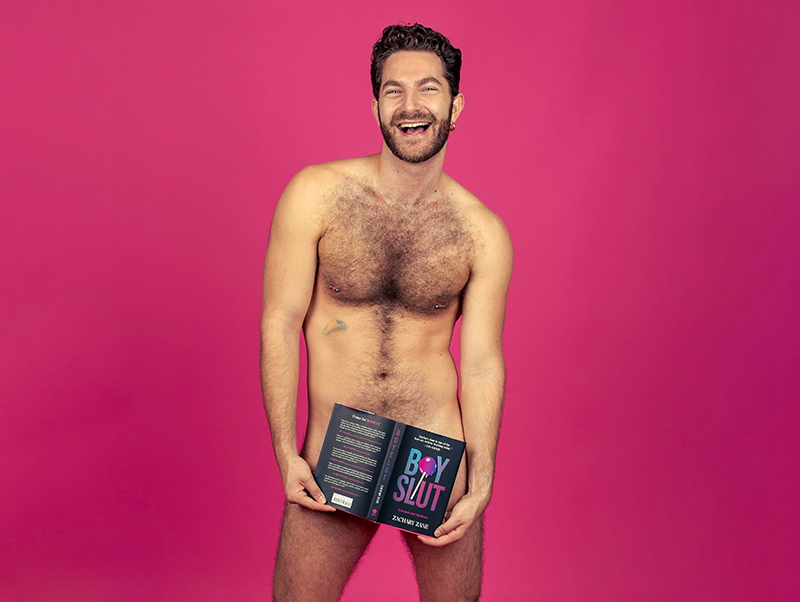Nearly 4 in 10 Metro Weekly readers never use condoms during sex
Unscientific survey reveals condom use prevalent, but not universal among readers, in time for International Condom Day

Just in time for International Condom Day, an unscientific poll of Metro Weekly readers finds almost 4 in 10 say they never use condoms during sex, with 70% of that sub-group saying they are also not on PrEP.
Created by AIDS Healthcare Foundation, International Condom Day is celebrated annually on Feb. 13 and employs creative ways of encouraging people to make healthier sexual choices, such as memes shared on social media, parody videos (such as a drag queen singing “When You Wear a Condom” to the tune of “When You’re Good to Mama” from the hit musical Chicago), public service announcements, or testimonial videos.
The message behind the day is to remind people that wearing a condom can prevent pregnancy and STDs, including HIV.
“We created this day in conjunction with Valentine’s Day (Feb. 14), as a fun way of promoting and encouraging people to use condoms, whether that’s to avoid pregnancy, or to help prevent HIV or avoid STDs. Rather than, you know, like sort of preaching to people or, you know, admonishing them or being like the school nurse, you know, doing it in a fun way,” notes Michael Weinstein, the president of AIDS Healthcare Foundation, which provides HIV and STI testing and treatment options across the nation, including three locations in the D.C. metro area.
“As far as where things with condoms stand right now, I would say that we’ve seen a drastic decline in condom use and I think we’ve seen condom culture decline drastically, which is something we predicted a while back — which is all the more reason for promoting it. Right now, when we’re trying to prevent people from becoming infected with COVID, we’ve had ads where we had a picture of a glove, a mask and a condom, with just the word ‘protection’ to promote the best public health interventions that we can,” notes Weinstein.
According to the unscientific survey, in which Metro Weekly readers could “opt-in” to take part, only about 24%, or fewer than 1 in 4, readers report “always” wearing a condom during sex. Another one-third, or 36%, say they “sometimes” use condoms. Respondents who opted in were almost universally gay males, with fewer than six percent overall identifying as another sexual orientation or gender identity.

Among those readers who use condoms, 42% said their preferred brand was Trojan condoms, with Durex and Lifestyles each being named as the second-most popular condom of choice by about 13% of respondents.

Readers were close to split evenly when it came to relationship status, with about 38% currently not in a relationship, 28% in an “open” relationship, and 33% in a monogamous relationship. Of those saying they “always” use condoms during sex, 44% were single, while 29% were in a monogamous relationship, and 27% were in an “open” relationship. Of those who never use condoms, 28% were single, 22% were in an open relationship, and 50% were monogamous.

Out of total respondents, only about 1 in 3, or 34%, said they were on PrEP, or pre-exposure prophylaxis, a daily medication that, when taken daily, helps lower the risk of transmission among sexually-active individuals. Of respondents who never use condoms, only 3 in 10 say they are currently taking PrEP.

Of those on PrEP, only 9% said they were in a monogamous relationship (such as a serodiscordant relationship, where one partner may be HIV-positive and the other negative), with about 44% saying they were not in any committed relationship, and 47% saying they were in “open” relationships.
See also: Injectable PrEP receives “breakthrough therapy” designation from FDA
Weinstein says advances in medication to treat HIV — which make the disease a manageable health condition — have led to changing attitudes around condom use.
“In the the ’80s, ’90s and early 2000s, people were a lot more afraid of HIV than they are now. Now, we are not watching people dropping like flies,” says Weinstein. “Now there are treatments that are one pill once a day with few side effects, so it doesn’t seem as ‘scary.’ On the other hand, when people become infected, it’s still a traumatic experience for many, many people. And it does require a lifetime commitment to taking medication.”
Weinstein claims studies have shown that the he biggest barrier to condom use, particularly among younger individuals, regardless of sexual orientation or gender identity, is cost and ease of access.
“They’re too expensive for younger people. We at AHF buy them for three-and-a-half cents wholesale and they retail [in stores] for a dollar. If there was a 25-cent condom in the convenience store at the checkout, where you could just buy condoms, that would help,” Weinstein says, noting that the issue of access is exacerbated by the fact that few public schools offer students condoms, out of fear of reprisal from parents and community members.
Additionally, he notes, there’s still a degree of embarrassment for people, especially younger people who are sexually active, to go into a store and buy condoms, especially if the local drug store or pharmacy keeps them under lock and key.
“I would say that STDs, including HIV, are still looked at as the wages of sin,” Weinstein says. “We are a country that is hedonistic in our behavior and moralistic in our attitudes, and that’s not a good combination.”

To make condoms more readily available to their residents, some cities and local governments have embarked on initiatives to increase condom availability. One such condom distribution program, run by the D.C. Department of Health, employs a two-pronged approach to improving access: having community partner organizations act as distributors, and setting up a mail-order program in which residents can request, through the Department of Health website, to have condoms shipped directly to their home.
Currently, the city partners with about 115 different sites, including businesses, government agencies, community centers, or other gathering places that serving as condom distribution centers, says Michael Kharfen, the senior deputy director of the HIV/AIDS, Hepatitis, STD, and TB Administration at the District of Columbia Department of Health.
“We have a link where people can sign up to be one of our community partners, and they can say how they would like to receive the types of condoms, what quantity, and the frequency, either monthly or quarterly,” says Kharfen. “The condoms come in boxes of a thousand each. So it’s up to those organizations to determine what their ideal quantity and frequency is. We also give them the option as to how they want to make those condoms available. Some choose to make them available to just their program participants, and others are willing to open up the distribution program to the public.”
As part of its direct-mail program, D.C. had been sending 10 condoms and 10 packets of lube to each person requesting condoms, Kharfen says, but has doubled that amount due to the pandemic in order to allow people to socially distance without having to seek out a distribution center. The mail-in program also allows people an option to request FC2 condoms, or condoms worn internally by the receptive partner, if they so desire.
See also: HIV diagnoses reach a record low among gay and bisexual men in the United Kingdom
Regarding the efficacy of the program, Kharfen says that the DC Health has a number of surveys examining the frequency of condom use by various communities, including gay and bisexual men, 75% of whom reported they had received free condoms through the program, while 55% of self-described heterosexual respondents said they had.
With respect to actual condom use, DC Health’s study of gay and bisexual men, performed every three years, found that 56% of respondents said they had used a condom the last time they had sex. By comparison, only 39% of heterosexual men and women respondents said they had.
“Overall, I would say that condom use has been fairly steady over the past few years. It has decreased a little bit among gay and bisexual men,” says Kharfen, although he notes that increases in the number of gay and bisexual men being prescribed PrEP may be affecting that number, despite warnings that PrEP does not protect against other non-HIV STDs.
“We asked D.C. residents about the last 10 times that they had sex and how many times they had used a condom. Just under half, or 48 percent, said they never used a condom. About six percent said they used a condom one to four times. Thirty-two or 33 percent, so about a third, said they used condoms five to 10 times. And about 10 percent weren’t sure or couldn’t remember,” he says.
“This begs the question, are these numbers good? Or not so good? It’s somewhat relative because your relationship status is what would determine whether you would or would not necessarily use condoms. And while we are very much, as the health department, in the habit of promoting condom use, we also recognize that for people who are say, in monogamous relationships, or in relationships where they know their health status, condoms might not be necessary for them,” he adds.
Kharfen also notes that the COVID-19 pandemic has led to a drop in condom distribution compared to recent years, as some of their community partners have been forced to close their doors due to social distancing or reduce their programming or hours of operation. But he also expects to rebound as more people get vaccinated for COVID and partner distributors begin resuming regular business.
“We’re currently working on a new promotional campaign and that will, we believe, will be very helpful in getting the message out about condoms and people’s access to them,” he says.
To request condoms from the D.C. Department of Health by mail, visit www.sexualbeing.org/get-condoms/free-condoms.
For more information about becoming a condom distributor, or to learn more about other Department of Health initiatives, visit dchealth.dc.gov/service/condoms-and-condom-information.
Read more:
Biden administration will investigate housing discrimination complaints from LGBTQ people
Support Metro Weekly’s Journalism
These are challenging times for news organizations. And yet it’s crucial we stay active and provide vital resources and information to both our local readers and the world. So won’t you please take a moment and consider supporting Metro Weekly with a membership? For as little as $5 a month, you can help ensure Metro Weekly magazine and MetroWeekly.com remain free, viable resources as we provide the best, most diverse, culturally-resonant LGBTQ coverage in both the D.C. region and around the world. Memberships come with exclusive perks and discounts, your own personal digital delivery of each week’s magazine (and an archive), access to our Member's Lounge when it launches this fall, and exclusive members-only items like Metro Weekly Membership Mugs and Tote Bags! Check out all our membership levels here and please join us today!

























You must be logged in to post a comment.